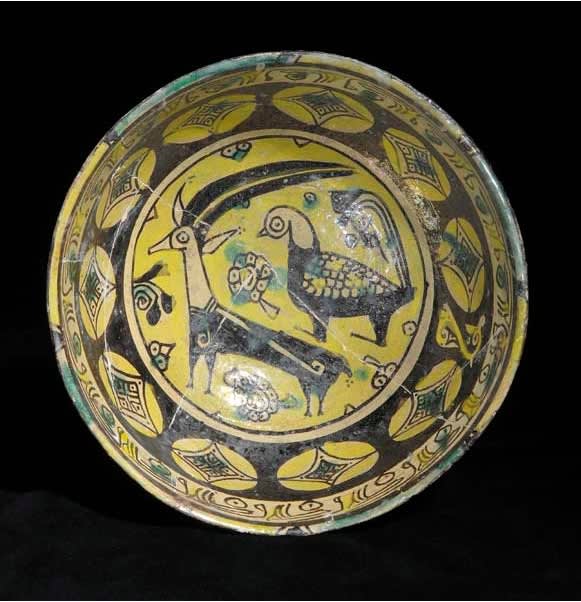Nishapur 'Buffware' Bowl, 900 CE - 1000 CE
Buff Earthenware
8.4 x 3.5
AMD.85
These early Islamic polychrome wares are among the most extraordinary of medieval ceramics, particularly for the verve and animation of the abstract designs they display and the vibrancy of their...
These early Islamic polychrome wares are among the most extraordinary of medieval ceramics, particularly for the verve and animation of the abstract designs they display and the vibrancy of their bold colors. From the lack of significant discoveries elsewhere it would appear that the so called Nishapur “Buff" or Polychrome Wares are specifically attributable to Nishapur. Very few such wares have been discovered elsewhere and the designs of those that have been found are very limited. The artistry reveals some influence of early monochrome luster painted pottery. This type is characterized by the yellow colored ground slip over which the dense decoration is painted in polychrome.
While other examples that appear to be related to this bowl and probably come from the same atelier exist in some of the finest collections in the world such as the Al-Sabah Collection in the Kuwait National Museum, (Cat. H.3 Bowl), the Khalili Collection, London (POT 1565) and the David Collection, Copenhagen (Inv.no.10/1964); this particular example is probably the finest in terms of quality and finesse with which the design was drawn and technically executed.
The question arises as to the meaning of the illustration and whether these invoke period meanings, possibly in reference to hunting or do they hark back to Sassanian and Zoroastrian iconography as many Buff-ware pieces undoubtedly do? In Manzandaran and Khurasan Sassanian conventions and traditions prevailed right up to the Mongol invasion. Some analysts such as Johanna Zick-Nissen have interpreted some figures to correspond with constellations, such that for example the gazelle or ibex would correspond with the constellation of Aries. The colors are vibrant and alive and the illustration is in the finest order of the genre, demonstrating the expertise of the early potter at his finest. The script around the cavetto has been swiftly and artistically written and may be a repetition of the word “baraka” or blessing.
While other examples that appear to be related to this bowl and probably come from the same atelier exist in some of the finest collections in the world such as the Al-Sabah Collection in the Kuwait National Museum, (Cat. H.3 Bowl), the Khalili Collection, London (POT 1565) and the David Collection, Copenhagen (Inv.no.10/1964); this particular example is probably the finest in terms of quality and finesse with which the design was drawn and technically executed.
The question arises as to the meaning of the illustration and whether these invoke period meanings, possibly in reference to hunting or do they hark back to Sassanian and Zoroastrian iconography as many Buff-ware pieces undoubtedly do? In Manzandaran and Khurasan Sassanian conventions and traditions prevailed right up to the Mongol invasion. Some analysts such as Johanna Zick-Nissen have interpreted some figures to correspond with constellations, such that for example the gazelle or ibex would correspond with the constellation of Aries. The colors are vibrant and alive and the illustration is in the finest order of the genre, demonstrating the expertise of the early potter at his finest. The script around the cavetto has been swiftly and artistically written and may be a repetition of the word “baraka” or blessing.
